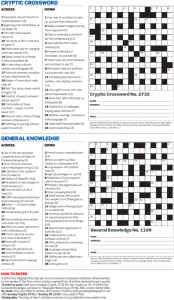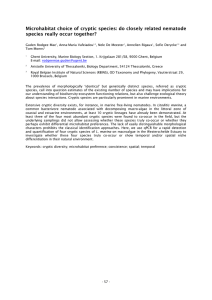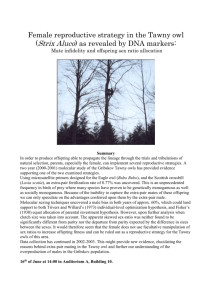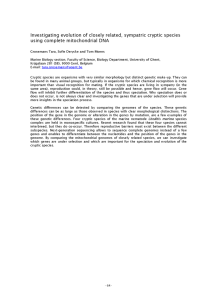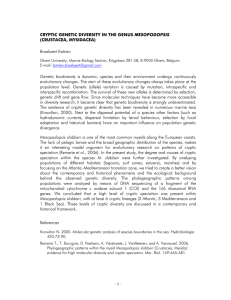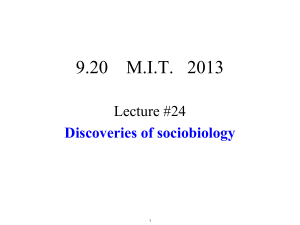9.20 M.I.T. 2013 Class 25
advertisement
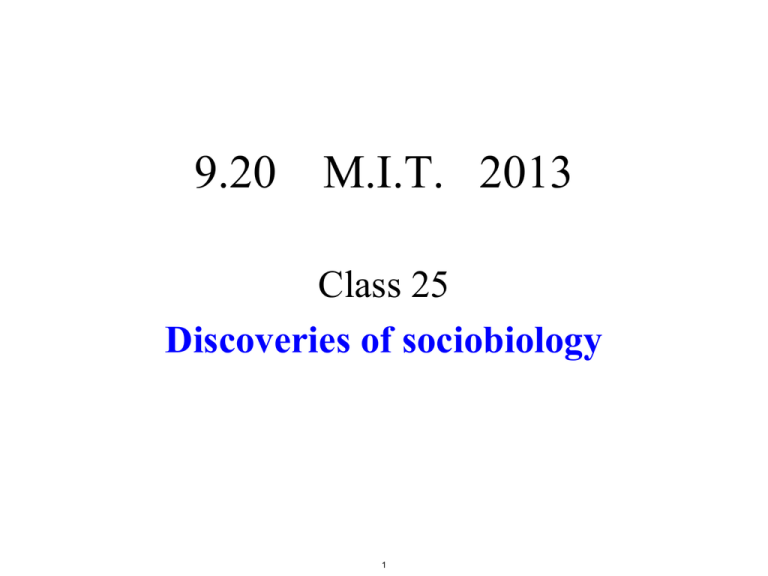
9.20 M.I.T. 2013 Class 25 Discoveries of sociobiology 1 John Alcock, The Triumph of Sociobiology, ch 6: Phenomena of cryptic female choice 10. What is meant by “cryptic female choice” in sociobiology? Would you expect such phenomena to be found in mammals? In humans? p 116 Next: examples of recent research with primates Manfred Eberle and Peter M. Kappeler (2004) Selected polyandry: female choice and inter-sexual conflict in a small nocturnal solitary primate ( Microcebus murinus) Behavioral Ecology and Sociobiology, 57(1) 2 Manfred Eberle and Peter M. Kappeler (2004) Abstract of report Please see: Eberle, Manfred, and Peter M. Kappeler. "Selected polyandry: female choice and inter-sexual conflict in a small nocturnal solitary primate (Microcebus murinus)." Behavioral Ecology and Sociobiology 57, no. 1 (2004): 91-100. 3 Ideas about the discovery of two kinds of sperm: “eusperm” & “parasperm,” with different functions: Spermicide, cryptic female choice and the evolution of sperm form and function (Holman L & Snook RR, J. Evolutionary Biology, 19: 1660 - 1670 Published Online: 10 Apr 2006) Summary of theoretical study on next slide 4 Ideas about the discovery of two kinds of sperm: “eusperm” & “parasperm,” with different functions: Please see: Holman, L., and R. R. Snook. "Spermicide, cryptic female choice and the evolution of sperm form and function." Journal of evolutionary biology 19, no. 5 (2006): 1660-1670. 5 How widespread might the phenomenon of sperm heteromorphism be? • Articles after 2001 on fishes, insects… – One example: next slide. – There are many others reported in the literature, including reports on mammals. 6 Please see: Holman, Luke, and Rhonda R. Snook. "A Sterile Sperm Caste Protects Brother Fertile Sperm from FemaleMediated Death in Drosophila pseudoobscura." Current Biology 18, no. 4 (2008): 292-296. 7 Alcock’s comment on “cryptic female choice” • p 116. 8 Further reviews: • Eberhard, William G (1996) Female Control: Sexual Selection by Cryptic Female Choice. • Baker, Robin (1996) Sperm Wars: The Science of Sex. Avolon Publishing Group [Includes speculations about humans—which made the book popular.] • Eliat, Ben-Ari (2000) Choosy Females: Exploring the role of cryptic female choice in sexual selection and battles over paternity. BioScience Vol. 50 No. 1 • Holman L (2006) Spermicide, cryptic female choice and the evolution of sperm form and function. Journal of Evolutionary Biology. 9 Reports: Spiders, cricket, beetle, flies, fish • Why study spider sex: special traits of spiders facilitate studies of sperm competition and cryptic female choice WG Eberhard - Journal of Arachnology, 2004 – BioOne spider • Complex genital structures indicate cryptic female choice in a haplogyne spider (Arachnida, Araneae, Oonopidae, Gamasomorphinae) M Burger, W Nentwig… - Journal of morphology, 2003 spider • Sexual conflict and cryptic female choice in the black field cricket, Teleogryllus commodus LF Bussiégre, J Hunt, MD Jennions… - Evolution, 2006 cricket • Male traits under cryptic female choice in the spotted cucumber beetle (Coleoptera: Chrysomelidae) DW Tallamy, BE Powell… - Behavioral Ecology, 2002 10 beetle More reports: • A time‐sequence functional analysis of mating behaviour and genital coupling in Drosophila: role of cryptic female choice and male sex‐drive in the evolution of male … fly S Jagadeeshan… - Journal of Evolutionary Biology, 2006 • Postcopulatory selection in the yellow dung fly Scathophaga stercoraria (L.) and the mate-now-choose-later mechanism of cryptic female choice fly PI Ward - Advances in the Study of Behavior, 2007 – Elsevier • Cryptic female choice during spermatophore transfer in Tribolium castaneum (Coleoptera: Tenebrionidae) [On the red flour beetle] beetle TY Fedina - Journal of insect physiology, 2007 – Elsevier • A mechanism for cryptic female choice in chinook salmon fish P Rosengrave, NJ Gemmell, V Metcalf, K McBride…- Behavioral Ecology, 2008 • Cryptic female preference for colorful males in guppies A Pilastro, M Simonato, A Bisazza… - Evolution, 2004 11 fish Another phenomenon re: different interests of male and female What is “genomic imprinting”? p 118-120: Studies in mice show different effects of the same particular gene, depending on whether it comes from the father or from the mother. (There are similar findings for the Igf2 gene and the MEST gene.) Male and female interests are not identical unless strict monogamy is practiced. Prediction: This phenomenon will be found in polygynous species but not monogamous species. This was tested and not verified in an initial test. Thus, the interpretation of the phenomena is not fully understood. DISCUSSION: What about human fetus sizes with the potential to damage or even kill the mother? It is (probably) not adaptive for the female, but it may be for the male. Without “genomic imprinting” it is hard to explain. 12 Illustration removed due to copyright restrictions. 13 It is of continuing and current interest: Genomic imprinting website; articles http://www.geneimprint.com/site/home "A model for genomic imprinting in the social brain: juveniles." Ubeda F, Gardner A. (2010) Evolution 64(9): 2587-600. Effects beyond the fetal and infancy periods "Imprinted and more equal." Jirtle RL, Weidman JR (2007) American Scientist 95: 143-149. "What good is genomic imprinting: The function of parent-specific gene expression." Wilkins JF, Haig D (2003) Nature Reviews: Genetics 4: 1-10. The following slide shows the most recent articles listed on the web site. 14 Exercise: Putting Action into Our Epigenome Denham J, Marques FZ, O'Brien BJ, Charchar FJ Sports Med (Oct 2013) Sexual differences of imprinted genes' expression levels Faisal M, Kim H, Kim J Gene (Oct 2013) Mapping human epigenomes Rivera CM, Ren B Cell 155:39-55 (2013) CTR9/PAF1c regulates molecular lineage identity, histone H3K36 trimethylation and genomic imprinting during preimplantation development Zhang K, Haversat JM, Mager J Dev Biol (Sep 2013) Beckwith-Wiedemann and Silver-Russell syndromes: opposite developmental imbalances in imprinted regulators of placental function and embryonic growth Jacob K, Robinson W, Lefebvre L Clin Genet 84:326-34 (2013) Environmental Epigenomics in Health and Disease Jirtle RL, Tyson FL Springer (May 2013)→ Feature Article and Press Reports Identification of an imprinted gene cluster in the x-inactivation center Kobayashi S, Totoki Y, Soma M, Matsumoto K, Fujihara Y, Toyoda A, Sakaki Y, Okabe M, Ishino F PLoS One 8:e71222 (2013) 15 Global epigenomic reconfiguration during mammalian brain development Lister R, Mukamel EA, Nery JR, Urich M, Puddifoot CA, Johnson ND, Lucero J, Huang Y, Dwork AJ, Schultz MD, Yu M, Tonti-Filippini J, Heyn H, Hu S, Wu JC, Rao A, Esteller M, He C, Haghighi FG, Sejnowski TJ, Behrens MM, Ecker JR Science 341:1237905 (2013) The haplotype-resolved genome and epigenome of the aneuploid HeLa cancer cell line Adey A, Burton JN, Kitzman JO, Hiatt JB, Lewis AP, Martin BK, Qiu R, Lee C, Shendure J Nature 500:207-11 (2013) Quantitative DNA methylation analysis improves epigenotype-phenotype correlations in BeckwithWiedemann syndrome Calvello M, Tabano S, Colapietro P, Maitz S, Pansa A, Augello C, Lalatta F, Gentilin B, Spreafico F, Calzari L, Perotti D, Larizza L, Russo S, Selicorni A, Sirchia SM, Miozzo M Epigenetics 8: (2013) Genomic imprinting is variably lost during reprogramming of mouse iPS cells Takikawa S, Ray C, Wang X, Shamis Y, Wu TY, Li X Stem Cell Res 11:861-73 (2013) Bisphenol a exposure disrupts genomic imprinting in the mouse Susiarjo M, Sasson I, Mesaros C, Bartolomei MS PLoS Genet 9:e1003401 (2013) Genome-wide allelic methylation analysis reveals disease-specific susceptibility to multiple methylation defects in imprinting syndromes Court F, Martin-Trujillo A, Romanelli V, Garin I, Iglesias-Platas I, Salafsky I, Guitart M, Perez de Nanclares G, Lapunzina P, Monk D Hum Mutat 34:595-602 (2013) REVIEW: CTCF and cohesin: linking gene regulatory elements with their targets Merkenschlager M, Odom DT Cell 152:1285-97 (2013) 16 Paternal obesity is associated with IGF2 hypomethylation in newborns: results from a Newborn Epigenetics Study (NEST) cohort Soubry A, Schildkraut JM, Murtha A, Wang F, Huang Z, Bernal A, Kurtzberg J, Jirtle RL, Murphy SK, Hoyo C BMC Med 11:29 (2013) Genomic responses in mouse models poorly mimic human inflammatory diseases Seok J, Warren HS, Cuenca AG, Mindrinos MN, Baker HV, Xu W, Richards DR, McDonald-Smith GP, Gao H, Hennessy L, Finnerty CC, Lopez CM, Honari S, Moore EE, Minei JP, Cuschieri J, Bankey PE, Johnson JL, Sperry J, Nathens AB, Billiar TR, West MA, Jeschke MG, Klein MB, Gamelli RL, Gibran NS, Brownstein BH, Miller-Graziano C, Calvano SE, Mason PH, Cobb JP, Rahme LG, Lowry SF, Maier RV, Moldawer LL, Herndon DN, Davis RW, Xiao W, Tompkins RG Proc Natl Acad Sci U S A 110:3507-12 (2013) Adaptive radiation-induced epigenetic alterations mitigated by antioxidants Bernal AJ, Dolinoy DC, Huang D, Skaar DA, Weinhouse C, Jirtle RL FASEB J 27:665-71 (2013)→ Feature Article and Press Reports REVIEW: Epigenetics in sports Ehlert T, Simon P, Moser DA Sports Med 43:93-110 (2013) NCBI Epigenomics: what's new for 2013 Fingerman IM, Zhang X, Ratzat W, Husain N, Cohen RF, Schuler GD Nucleic Acids Res 41:D221-5 (2013) REVIEW: Importance of the matriline for genomic imprinting, brain development and behaviour Keverne EB Philos Trans R Soc Lond B Biol Sci 368:20110327 (2013) 17 Next: back to bird behavior 18 John Alcock, The Triumph of Sociobiology, ch 6: Helping parents rear siblings 11. Among Seychelles warblers, what are the advantages for young birds if they help their parents rear siblings by becoming a “helper-at-the-nest”? (clearly a form of altruism)? p 123-124 (Alcock goes further with this topic than Scott’s book did.) Photo removed due to copyright restrictions. 19 John Alcock, The Triumph of Sociobiology, ch 6: Helping parents rear siblings 11. Among Seychelles warblers, what are the advantages for young birds if they help their parents rear siblings by becoming a “helper-at-the-nest”? (clearly a form of altruism)? p 123-124 -- They gain experience -- They promote the survival of close relatives. -- They can inherit the territory. Helpers are usually female. They are used by adult pairs that have the better territories. 20 John Alcock, The Triumph of Sociobiology, ch 6: Regulation of sex of offspring by Seychelles warblers 12. In his studies of these warblers, the sociobiologist J. Komdeur (1997) made a surprising discovery: Females can regulate the sex of their offspring. Why has this ability evolved? Explain in terms of female fitness, and behavioral differences between male and female offspring. p 126-127 “Prior to the sociobiological era, no one checked whether birds could ‘choose’ which sex to produce in their offspring.” 21 Seychelles warblers: On good territories, a “helper at the nest” is beneficial. Usually the helper is a daughter. On poor territories, there is insufficient food for the extra bird. Using sociobiological reasoning, Komdeur tested for the possibility that females can bias the sex of offspring, to increase the probability of getting a helper if she had a good territory. RESULT: On poor territories, 77% males were hatched. On rich territories, 13% males were hatched. 1996 & 1997 papers 22 Soon after Komdeur’s first report, a related finding appeared on tawny owls: Proc. R. Soc. Lond. B 22 August 1997 vol. 264 no. 1385 1111-1116 Does variation of sex ratio enhance reproductive success of offspring in tawny owls (Strix aluco)? Appleby et al. Tawny owls laid female-biased clutches on territories with more abundant prey (field voles) in June, the month that chicks fledge. Eggs were laid in March. Adaptive because females get a reproductive advantage from being reared under good food conditions. 23 Tawny owls: The sex-biasing decision by the owls must be made in March, based on a prediction of what the prey density will be in June! Sex-biasing phenomena were known earlier, but benefits for genetic fitness were not investigated before Komdeur and this study of tawny owls. 24 From the introduction to the paper on tawny owls: Please see: Appleby, Bridget M., Steve J. Petty, Jeremy K. Blakey, Paul Rainey, and David W. MacDonald. "Does variation of sex ratio enhance reproductive success of offspring in tawny owls (Strix aluco)." Proceedings of the Royal Society of London. Series B: Biological Sciences 264, no. 1385 (1997): 1111-1116. 25 Comparative studies, continued: Please see: Byholm, Patrik, Esa Ranta, Veijo Kaitala, Harto Lindén, Pertti Saurola, and Marcus Wikman. "Resource availability and goshawk offspring sex ratio variation: a large‐scale ecological phenomenon." Journal of Animal Ecology 71, no. 6 (2002): 9941001. Note that the relationship between food availability and the offspring sex ratio varies. The problem is to discover the most likely reason for one or the other sex bias. 26 A mechanism for manipulation of sex ratio in starlings: PhD thesis by Oliver P. Love (2007), Simon Fraser University, British Columbia • In starlings, intra-specific variation in plasma corticosterone is related to maternal condition and high baseline levels are associated with nest abandonment. [Corticosterone is higher with greater stress.] • …experimentally elevated yolk corticosterone selectively decreases male offspring quality and increases pre- and post-natal male mortality. • For the mother, the result is an allocation towards evolutionarily less-expensive daughters and a sex-specific lowering of current reproductive investment. • Exposing offspring to the effects of maternal corticosterone plays adaptive roles at multiple reproductive stages and ultimately increases maternal fitness. 27 John Alcock, The Triumph of Sociobiology, ch 6: Why would a male bird exercise the adoption option by becoming a step-parent? 13. See Appendix, Ch 6, Q 1 1) Benefits for his genetic fitness? • Future helper? • Future mating opportunities, when mates may be hard to find. 2) A result of proximate mechanisms operating in an abnormal situation. 28 Next: more notes from E.O. Wilson, Sociobiology (1975, 1980) 29 MIT OpenCourseWare http://ocw.mit.edu 9.20 Animal Behavior Fall 2013 For information about citing these materials or our Terms of Use, visit: http://ocw.mit.edu/terms.
